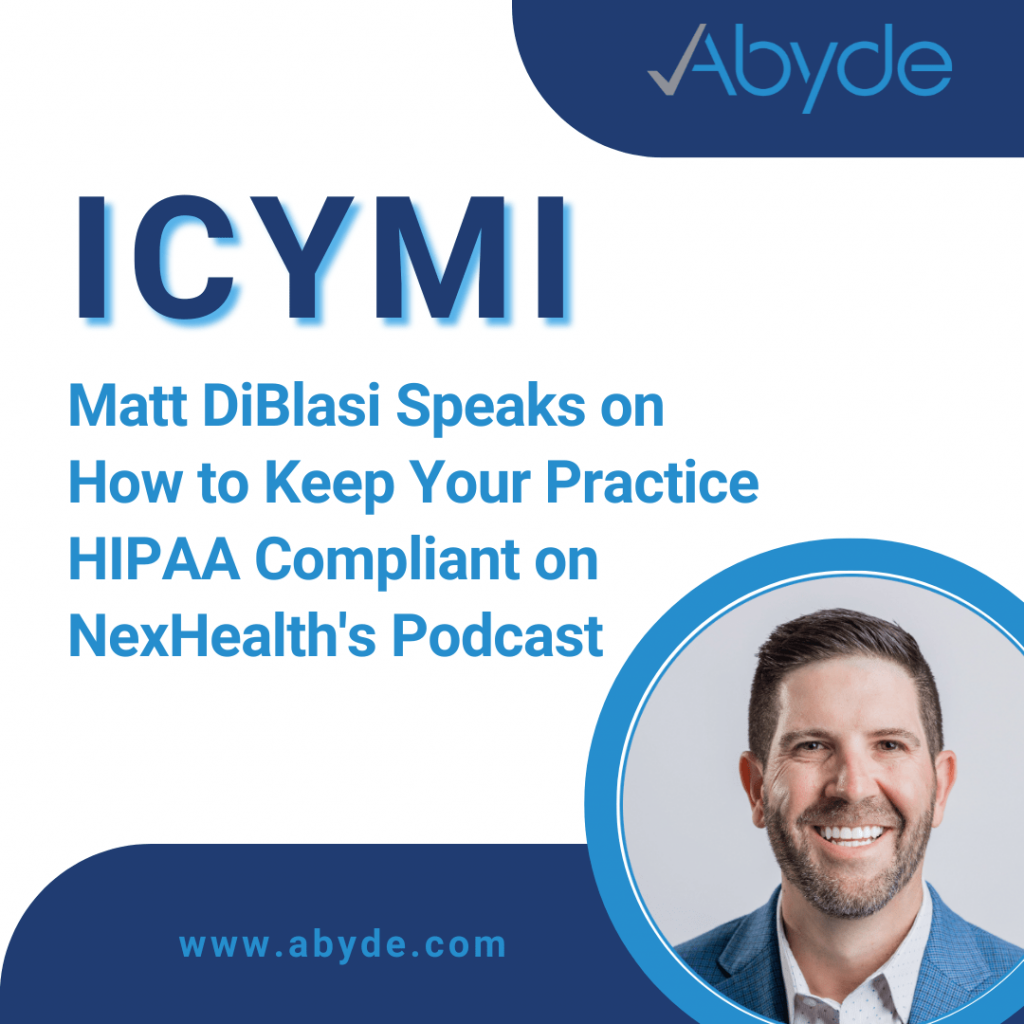June 20, 2023 In Case You Missed It: We are sharing some exciting insights from our CEO, Matt DiBlasi’s recent conversation on NexHealth’s podcast, How I Grew My Practice. This discussion explores the intricacies of HIPAA compliance and the crucial role data security plays in healthcare. In this interview, Matt simplifies the complex landscape of HIPAA compliance and we want to highlight some key takeaways here. Whether you’re a healthcare professional, an office manager, or just curious about compliance, you’ll find value in Matt’s expert perspective. ✍ Documentation – Matt stresses the importance of streamlining HIPAA compliance by segregating it into digestible, actionable steps. The security risk analysis (SRA) is the first and fundamental stride towards this accomplishment. Just as tax payments require accurate records, organizations must produce verifiable evidence of their commitment to compliance. SRAs are crucial for pinpointing potential weaknesses and instituting protective measures for critical data. 🎓 Education – A common obstacle organizations face in striving for HIPAA compliance is the need for adequate education and knowledge. Matt asserts that the size of the organization or the practice does not influence its responsibility toward HIPAA compliance. Practices need to be more aware of vulnerabilities due to insufficient knowledge. Here, dependable sources for educational insights become invaluable. Professional organizations, like dental and medical associations, often serve as excellent platforms for understanding the nuances of HIPAA compliance. 🔁 Consistency – While different healthcare practices may have unique quirks, the HIPAA compliance prerequisites are identical across all sectors. Office and business managers are typically tasked with ensuring compliance, often dealing with constraints in resources and expertise. Instituting a comprehensive compliance protocol that aligns with the required physical, technical, and administrative safeguards can minimize risks and secure compliance. 🛑 Non-Compliance – Ignoring the priority of HIPAA compliance can result in grave implications for practices. Matt warns, “You risk your practice, livelihood, patients, and their data.” Besides the financial consequences like penalties, non-compliance can trigger reputational damage, patient grievances, and cumbersome regulatory investigations. Proactive measures in establishing a compliance program facilitate vulnerability identification, risk mitigation, and avoidance of potential breaches. 🛠 HIPAA-Compliant Technology Partners – Choosing the right technological collaborators is vital to preserving HIPAA compliance. These third-party vendors must uphold HIPAA regulations. Practices must form business associate agreements with these partners to confirm their handling of sensitive data and adherence to security protocols. Navigating the complexities of HIPAA compliance is a crucial element of healthcare practices. By implementing the strategies shared by Matt, organizations can streamline compliance through adequate documentation, access dependable, educational resources, maintain standardization across diverse practices, comprehend the ramifications of non-compliance, and choose technology partners wisely. Emphasizing HIPAA compliance shields confidential patient data and fortifies the practice’s reputation and operational efficiency. Watch the entire interview here: https://www.nexhealth.com/resources/hipaa-compliance-matt-diblasi?utm_source=twitter&utm_medium=social. Are you eager to learn more about HIPAA and OSHA compliance? Do you need help navigating the complex requirements to protect your healthcare practice? We’re here for you. At Abyde, our team of experts are ready to guide you through every step, offering customized solutions catering to your unique needs. Don’t leave your practice’s safety and compliance to chance. Reach out to us today, and we can ensure your practice’s smooth, compliant operation. Let’s navigate the complexities of compliance together and NEVER STRESS OVER COMPLIANCE AGAIN!
Abyde Wins “Best Places to Work 2023” Award by Tampa Bay Business Journal
April 28, 2023 CLEARWATER, FLORIDA, UNITED STATES, April 28, 2023/EINPresswire.com/ — FOR IMMEDIATE RELEASE Abyde Wins “Best Places to Work 2023” Award by Tampa Bay Business Journal Abyde, a leading provider of healthcare compliance solutions, is proud to announce that it has been named one of the “Best Places to Work” in 2023 by the Tampa Bay Business Journal. This prestigious recognition celebrates the company’s commitment to fostering a supportive and innovative work environment for its employees while continually driving growth and success in the healthcare compliance industry. Abyde’s dedication to creating a positive company culture and outstanding work environment has been instrumental in its ability to attract and retain top talent in the industry. This focus on employee satisfaction, combined with the company’s innovative products and services, has contributed to Abyde’s rapid growth and success in the healthcare compliance market. “We are incredibly honored to receive this award from the Tampa Bay Business Journal,” said Matt DiBlasi, President and Co-Founder. “Our team is the driving force behind Abyde’s success, and we firmly believe that investing in our employees’ well-being, professional development, and overall satisfaction is crucial to achieving our mission of simplifying healthcare compliance for providers and practices nationwide.” The “Best Places to Work” award is determined through an extensive evaluation process, which includes surveying employees about their experiences at work, assessing company culture, and considering various workplace policies and benefits. The Tampa Bay Business Journal has recognized Abyde as an exceptional employer due to its focus on employee empowerment, competitive compensation packages, and comprehensive benefits, which include health insurance, paid time off, professional development opportunities, and flexible work arrangements. As part of its commitment to fostering a thriving company culture, Abyde prioritizes giving back to the local community. The company supports various philanthropic initiatives, including volunteering, fundraising, and donating resources to local non-profit organizations. About Abyde Abyde is a leading provider of healthcare compliance solutions, helping medical practices and healthcare providers across the United States navigate complex regulatory requirements with ease. Through its innovative software and personalized support, Abyde empowers healthcare organizations to maintain compliance, streamline operations, and focus on what matters most – providing exceptional patient care. For more information, visit abyde.com. Abyde Marketing+ +1 800-594-0883marketing@abyde.comVisit us on social media:FacebookTwitterLinkedIn
Abyde | 2022
December 31, 2022 As we wrap up this year, we want to take a look back at our biggest wins. Of those, the ones that stand out most to us aren’t defined by dollar signs or broken records – although, we have seen some pretty impressive performance throughout 2022. When we look at all we have accomplished over the last twelve months, we are most proud of the impact we have made in our community and for our people. Now as AJR says, can we skip to the good part? There is so much to be proud of this year, as you can see. We are set up to carry this same energy into 2023! As the New Year rolls around, we wish you all nothing but peace and prosperity.
Abyde expands HIPAA compliance solutions to serve enterprise-level organizations
March 2, 2021 Abyde, a user-friendly HIPAA compliance software solution designed for independent providers, today announced the launch of a new complementary Enterprise product designed with medium to large organizations in mind. HIPAA compliance has remained a priority for the Office for Civil Rights with historic enforcement activity in 2020. Recently announced audit data revealed only 2% of covered entities met all HIPAA compliance requirements, and only 14% completed the required Security Risk Analysis to assess their physical, technical and administrative safeguards. For larger organizations, implementing an efficient HIPAA compliance program for multiple locations has remained a daunting task. Abyde Enterprise works to solve these HIPAA headaches, allowing HIPAA program administrators to easily navigate between locations, view their compliance program at a glance, and simplify shared compliance responsibilities with an innovative multi-user functionality. The complementary product reimagines Abyde’s already industry-leading features, which guide providers through mandatory HIPAA requirements, with new tools and reporting capabilities to better serve organizations who have 2 to 2,000 locations. “Abyde Enterprise is a game-changer for larger organizations and just another example of how Abyde is revolutionizing HIPAA compliance,” said Matt DiBlasi, President of Abyde. “We’re thrilled to bring to market a one-of-a-kind solution that will truly make HIPAA compliance as easy as possible for companies who must effectively manage multiple locations.” “Abyde Enterprise is all I’m ever going to need for HIPAA compliance,” said Amanda Bailey from Triad Eye, an Abyde user who recently upgraded to Enterprise. “I’ve been really impressed how Abyde Enterprise might be even easier to use than standard Abyde – which I could have never thought was possible! Every multi-location practice out there should be using Abyde Enterprise!” About Abyde Abyde is a healthcare technology company on a mission to revolutionize HIPAA compliance for medical professionals. Launched in 2016, Abyde has become the preeminent solution for independent practices to achieve and maintain government-mandated HIPAA compliance, serving thousands of practices of all sizes across the nation. The industry-leader, Abyde combines an intuitive software with personal support for an experience so simple, ‘easy’ is an understatement. To see how, visit abyde.com today. Read the full press release here.
Abyde President, Matt DiBlasi, Featured Article in Optometric Management Magazine
April 20, 2017 The article below was featured in the April edition of Optometric Management Magazine. To see it on their website, click here. ARE YOU HIPAA COMPLIANT? THESE FIVE STEPS CAN HELP YOUR PRACTICE SECURE PATIENT INFORMATION By Matt DiBlasi, St. Petersburg, Fla.April 1, 2017 THANKS TO the HITECH Act, Meaningful Use and the Medicare Access and CHIP Reauthorization Act (MACRA)/Merit-based Incentive Payment System (MIPS), the number of optometrists using EHRs will be at an all-time high by the end of 2017. Many practices are trying to implement software, install IT networks, ensure data backups are running properly and integrate diagnostic technology, such as optical coherence tomography devices, into electronic information systems. For established practices the overwhelming sentiment is, “This is not what I went to school for!” While that statement may be true, O.D.s must embrace this technology. It is tied closely with The Health Insurance Portability and Accountability Act of 1996 (HIPAA) and, thus, the survival of one’s practice. Whether it is patient names, Social Security numbers, dates of birth or medical histories, the data stored in EHR is extremely profitable to those with malicious intent. In fact, this protected health information (PHI) is 10x more valuable than credit card information on the black market, reports Reuters. This makes optometry practices targets for criminals. (See “Securing Your Practice,” p.23.) To ensure you’re complying with the latest HIPAA security requirements, consider following these five steps. 1 PERFORM A RISK ANALYSIS This is a self-evaluation in which a practice must identify safeguards in place to secure PHI, as well as identify potential risks to the confidentiality of that same sensitive information. For example, many practices do not change computer and server passwords on a regular basis — a potential risk. As a result, my company recommends computer and server passwords be changed at least 3x per year, as anything less frequent would be considered an elevated risk. The Office for Civil Rights (OCR) at the United States Department of Health & Human Services is clear in explaining that the risk analysis is the first step in a practice’s HIPAA security compliance efforts. Without one, a practice cannot be considered HIPAA compliant. In the case of a HIPAA audit, data breach precaution is the first item the OCR will require from a practice as proof of risk analysis. (The first thing the government will ask for in case of an audit is proof of risk analysis). This makes it vital for practices to have their risk analyses easily accessible and up to date. The five categories to consider when documenting the risk analysis are (1) physical, (2) technical, (3) administrative, (4) policies and procedures and (5) organizational requirements. (See tinyurl.com/RAHHS .) Pro tip. Rather than updating the risk analysis once per year, make it a habit to update it, at minimum, on a quarterly basis to save a substantial amount of time. Securing Your Practice 2 DOCUMENT POLICIES AND PROCEDURES No matter the size of your practice, it is imperative to document all HIPAA policies and procedures for your organization, as the 2016 HIPAA Audit Protocol mandates policies and procedures be reviewed in the case of an OCR audit. While it may seem like overkill for smaller optometry practices to have a full complement of documented policies, doing so can be beneficial in the case of disaster recovery efforts or streamlining the onboarding/off boarding process for employees. Pro tip. Make sure policies and procedures are specific to your organization’s processes. In other words, avoid using generic online or purchased templates that can give a false sense of security that you are meeting the HIPAA policy and procedure requirement. Examples of policies: access authorization, disaster recovery plan, email and fax transmission and employee hiring and termination. 3 CREATE A HIPAA TRAINING PROGRAM Many practices conduct HIPAA training for all staff (full/part-time), but few may be meeting OCR’s training requirement. This requirement: Not only must HIPAA training be completed, at minimum, once per year for all employees, but training requirements also mandate that it be concluded in a modular format. This means documented proof is required that a quiz was taken by each employee. Pro tip. Make sure new employees go through a formal HIPAA training program and take an associated quiz within 90 days of being hired, or “in a reasonable time frame.” 4 REQUIRE BUSINESS ASSOCIATE CONTRACTS Also known as BACs, these offset liabilities in the case of a data breach. With the majority of data breaches caused by business associates (CPA firms, attorneys, consultants) and not internal employees, the importance of getting BACs signed cannot be understated. If a business associate will not sign a BAC, realize that by continuing to work with him or her, the practice is taking on a huge liability risk. (See tinyurl.com/BACHHS .) Pro tip. Every BAC is worded differently, so be sure to identify when the BAC expires. 5 ENCRYPT OR SECURE PHI You may understand the importance of ensuring servers and backups are encrypted properly, but have you ensured other applications, such as your email, are secure? Emails containing PHI should never be sent under any circumstance unless encrypted or secured. Also, remember that every time a document is scanned or printed to a multi-function device, a copy is saved to the internal hard drive. If hard drives are not encrypted or wiped properly and the device is returned at the completion of a lease or sold to another business, a data breach can occur. Pro tip. Most all-in-one printers/copiers/scanners provide a HIPAA-compliant security or encryption package. If these are not available for your device, work with an IT professional to wipe and delete hard drives properly before disposing of the system. Total Complaints Investigated 36,048Source: HHS.gov PROTECT YOUR BUSINESS While many practices feel burdened by the added responsibilities of technology, such as EHR, lack of time to interpret HIPAA security requirements is not an accepted excuse when a HIPAA audit reveals problems. Follow the steps outlined above, and consider reaching out to a third party for questions, concerns or if you just need help. OM MR.




